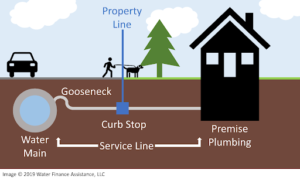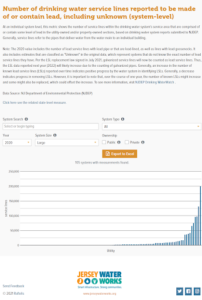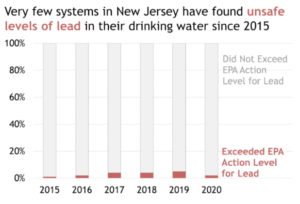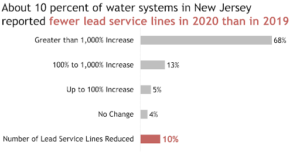Jersey WaterCheck Data Show New Jersey Water Systems Actively Identifying and Eliminating Lead Service Lines
Identifying and removing lead service lines from our water systems is one of the most urgent issues in drinking water today—in New Jersey and around the country. President Biden has repeatedly stated his goal of removing all lead service lines from water systems across the country, which will likely feature as a requirement when the EPA issues its revised Lead and Copper Rule. The recently passed Infrastructure Investment and Jobs Act includes $15 billion for lead service line identification and replacement projects over the next five years. Here in New Jersey, Governor Murphy signed legislation in July that requires public community water systems to inventory and replace all lead service lines within 10 years. But even before the new legislation and funding opportunities, many water systems in New Jersey made progress in the past year identifying and eliminating lead service lines. Newly updated data on Jersey WaterCheck helps us track their progress.
Service lines are the pipes that connect drinking water systems to individual homes and businesses. Lead was a commonly used material for these service lines until the U.S. Congress banned its use in 1986 due to health concerns. While no new service lines could contain lead, Congress did not at that time mandate that water utilities replace lead lines that were already in the ground. Lead exposure can be dangerous to humans of any age, but children are particularly at risk, because lead exposure can permanently impact brain development.

All the new laws, regulations, and funding programs should accelerate the pace at which lead service lines are being identified and removed across the country, but that process is already well underway here in New Jersey. Just two years ago, headlines compared the Newark lead contamination “crisis” to the crisis in Flint. But, Newark’s aggressive lead service line replacement program has successfully removed 20,000 lead lines in 24 months and is now heralded as a “national model” of how to replace lead service lines quickly, safely, and efficiently.
Newark is one of more than 100 water systems in New Jersey that has identified lead service lines to be replaced. How are the other communities fairing? One important source of data to answer this question is Jersey WaterCheck.
Jersey WaterCheck was created by Jersey Water Works (JWW) to tell the story of our state’s water and wastewater infrastructure needs. One of JWW’s shared goals is “Effective and Financially Sustainable Systems,” and there are six metrics tracked under that shared goal related to lead service lines and lead exposure. Jersey WaterCheck tracks the number of lead service lines identified at the state level and at individual water systems, as well as the number of lead service lines replaced at the state and system levels. Jersey WaterCheck also tracks whether a water system had any samples that equaled or exceeded EPA action levels for lead. All these metrics can be found under the “Maintaining Systems” sub-goal.

The presence of lead service lines does not automatically mean that customers’ drinking water delivered through that line will be exposed to unsafe levels of lead. Utilities can use corrosion control measures to limit the likelihood that lead will leech out of service lines and into drinking water, but it is not a guarantee. Thankfully, most systems in New Jersey deliver water to customers that does not contain unsafe levels of lead. Since 2015, only about 1-4% of water systems statewide had any water samples in which the lead level exceeded the level that the EPA has determined to be safe (the “action level”). Over the past year for which there is data, the number of systems reporting an unsafe level of lead in New Jersey dropped from 5% to 2%.

These are positive numbers, but obviously the long-term goal is for no water systems in New Jersey to exceed the EPA’s standard. Ideally, we want to see no lead at all in drinking water. The only way to achieve this goal is to remove lead pipes and other lead fixtures from within drinking water systems entirely—to follow the example of Newark. Many other communities in New Jersey are taking action right now to eliminate lead pipes.
Before a water system can remove any lead pipes, it first has to identify which of its service lines are made of lead. Water systems did not necessarily have a reason to keep track of the pipe material of service lines in the past, so any service line installed before the Congressional ban in 1986 could in theory contain lead.
New Jersey’s water systems collectively have more than 2,420,000 service lines, according to recent data from the EPA’s Safe Drinking Water Information System. How many of these contain lead?
From 2019 to 2020, the number of identified lead service lines rose from 170,281 to 1,150,645, and 90% of water systems with identified lead service lines saw their count rise from 2019 to 2020. This significant change requires some important context. The 2020 count included service lines of unknown material in the count for the first time, which likely accounts for much of the increase (and data in the coming year will include galvanized lines for the first time, meaning we expect another year of large data changes). As a result, comparing these two numbers is like comparing apples to oranges.
Nevertheless, many of our water systems are actively working to protect public health by taking the important first step of identifying lead service lines. This is an enormous task requiring significant time and effort, and it will clearly continue to be a priority for systems in the coming years.
Data from Jersey WaterCheck also show that several water systems in New Jersey, in addition to Newark, have begun the process of replacing their lead service lines. Almost 10% of water systems with lead lines reported fewer lead service lines in 2020 than they did in 2019, indicating that lead service line replacement efforts were well underway. A handful of systems are close to eliminating all their identified lead service lines already.

In addition, some utilities that reported an increase in lead service lines identified from 2019 to 2020 also reported that they replaced some of those lead service lines over the same period. Trenton Water Works, for example, replaced more than 4,000 lead service lines in 2019 and 2020.
Many water systems in New Jersey still need to identify their service line pipe material, and there are certainly many lead service lines left to replace. But even without state and federal mandates and funding, many water systems have made significant progress in tackling the public health threat of lead in drinking water. In future years, the data in Jersey WaterCheck will allow us to continue to monitor their progress and to measure the impact that the new mandates and funding will have. Check out Jersey WaterCheck and follow along with New Jersey’s progress!